Contents:
- Biology
- Difference from cranberries
- Harvesting cranberries
Cranberries are a real storehouse of vitamins, this assertion is not disputed by anyone, and therefore the berry is collected wherever it grows. Prepare it in autumn until the moment when the snow covers it with a soft fluffy blanket, and also in the spring, after the snow cover has fallen.
For a more complete initial acquaintance with the subject of our conversation, we will immediately provide you with a photo of how the cranberry grows.
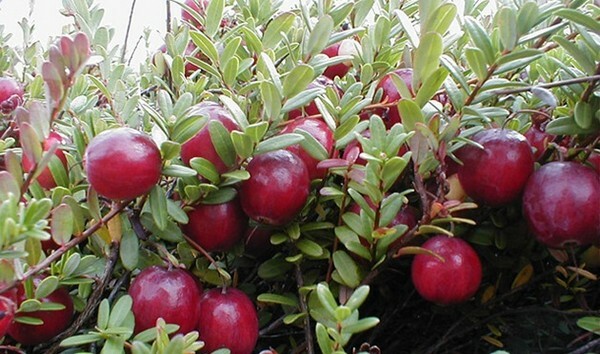
The origin of its name is the Greek cranberry, in translation from which, it literally means "sour berry".Often it is also called "Zhuravinka", and not only in Slavic - Russian, Belarusian and other languages, but also in German and English. Similarity with the crane gives it the location of berries on long branches, like the thin necks of a bird.
Biology
The story of the berry begins with its biological characteristics, morphology and description of its distribution.Scientific classification
Cranberry is a subgenus of the genus of the family of the heath family, includes four types:
- vaccine red;
- cranberry smallfruit;
- cranberry;
- cranberries are large-fruited.
Morphology
All listed species of cranberries are nothing but a low, creeping shrub with shoots up to 30 centimeters in length, which, when in contact with the soil, can take root in it. The core system of cranberries forms mycorrhizas with one species of fungi, which is able to extract nutrients from the marshy soil, than the shrubbery successfully uses.
Attention! Thanks to this mycorrhizal cranberries are not demanding on the soil, it receives food from the finest threads of a friendly fungus.
Cranberry leaves are located along the branches in the so-called next location, they are from 3 to 15 millimeters in size, while the berries often exceed their size, reaching a diameter of 16 millimeters.
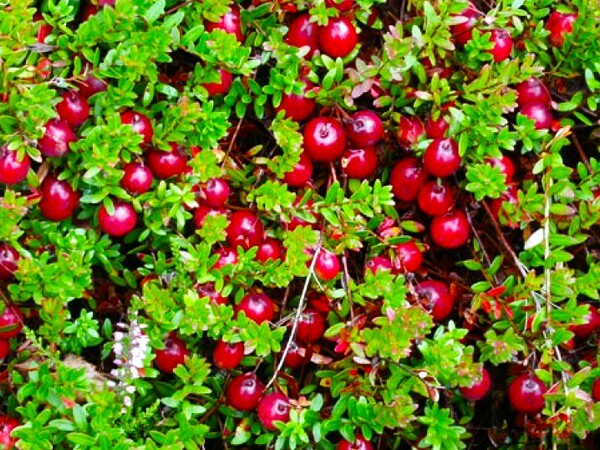
Cranberry flowers drooping, various shades of red, they grow on a long stem, up to 50 millimeters in length.
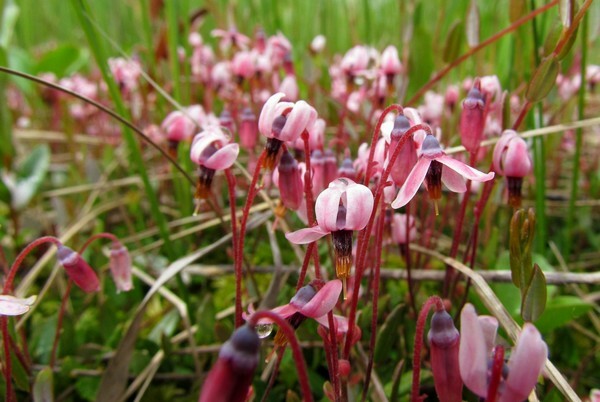
Spreading
Without paying attention to the vaccine, we suggest you familiarize yourself with the scheme of where cranberries grow on the globe.

Green area on the map shows the distribution of large-fruited cranberries, orange - small-fruited, red - ordinary.
Warning! As can be seen in the presented photo, the largest area is the common cranberry, the largest one grows only in North America, and the small one in Eurasia.
Regardless of the continent and species, the marsh cranberry grows mainly in marshy areas, peat soils or coniferous forests with sphagnum moss. The berry also settles along the marshy muddy banks of rivers.
Vegetation
Depending on the region of growth, the phenological characteristics of cranberries change.
Our reference! Phenology is a collection of knowledge about the seasonality of natural phenomena, including the stages of plant development.
Flowering occurs in May at the southern boundary of the range or in June in the north. The contemplation of how the cranberries blossom does not leave anyone indifferent. It seems that the bush does not blossom, and ordinary hummocks on the marsh are painted in colors from light pink to dark purple. This riot of colors on plain-looking marshland usually lasts about three weeks.
In the summer of the flowers appear berries. At first they are not large and have a white color, but closer to the autumn, the moment of maturation, they are painted in red, sometimes to purple hues. When the cranberries ripen, the swamp again as if someone is painting.
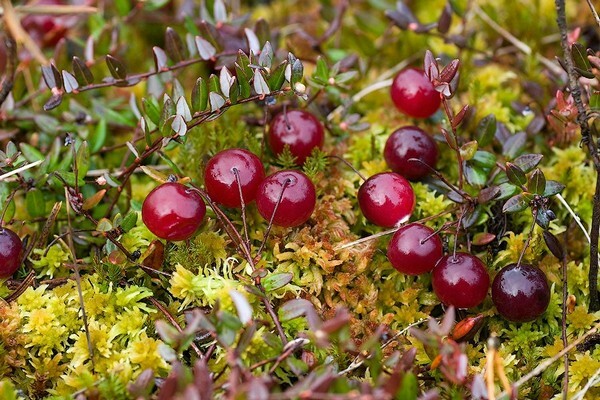
Difference from cranberries
Often uninitiated people confuse our today's heroine with another representative of heather - cowberry. And in fact, at first glance it is rather difficult to distinguish them, but, nevertheless, having looked closely, it is easy to identify this or that berry.
The first sign of the difference between cranberries and cranberries is the place of growth. As a rule, cowberries choose more dry and elevated areas compared to their cousin.
By the way! Cranberries and cranberries are also similar to bearberry, whose berries have no special nutritional value, and the leaves are used only for medicinal purposes in the form of teas, in particular as a diuretic.
The second difference between the two berries is the ratio of fruit and leaves. In cranberries they are approximately equal in size, while in cranberries the berries prevail. In addition, cowberry leaves are more rounded in shape.
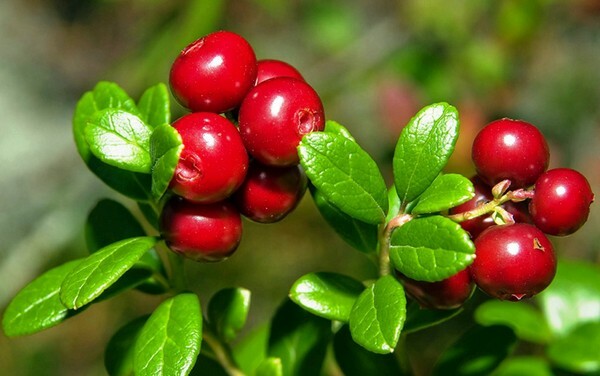
The third sign is the dimensions, and this applies to plants as a whole, and the size of berries. Cowberry is much lower than its sister, the growth of its bushes does not exceed 15-20 centimeters, and the size of berries is only 8 millimeters.
The following difference can be seen during the flowering of berry. Unlike cranberry flowers on long pedicels, the latter are short in cranberries - look at the next photograph.
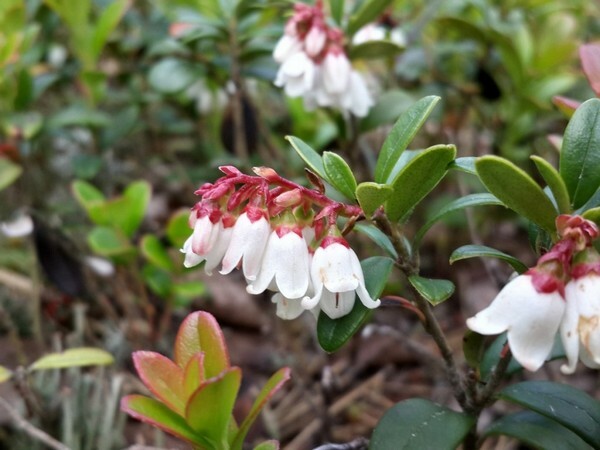
Our reference! These berries are similar not only in nutrition from fungi, but also in the method of reproduction and propagation. There is such a phenomenon as ornithochory - the spread of seeds by birds.
Harvesting cranberries
When to harvest
Cranberries are harvested in the autumn before the snow falls and in the spring after its melting. Preferably still the first option. But here there are nuances.
When do they collect cranberries? Everything depends on the locality of its growth. The signal to the collection is the darkening of the berries. The collection of unripe cranberries is reflected in the quality of the crop, its nutritional and medicinal value.
Experienced harvesters note that it is best to harvest cranberries after the berries touched the first frost, under its influence the berries become sweeter and acquire a unique aroma.
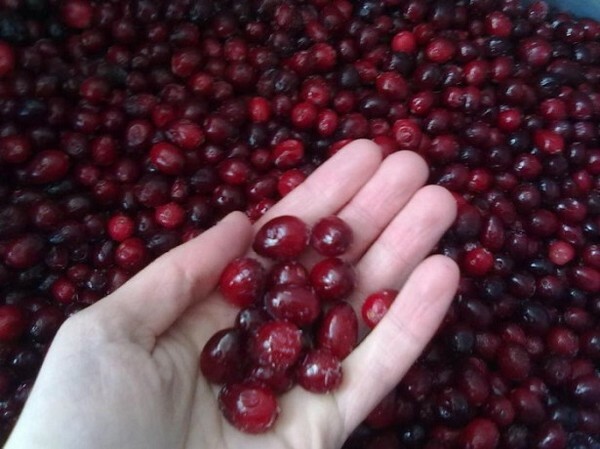
Help! The harvested unripe berries of cranberries have a property to be dispensed, but their nutritional value is lost.
The berries that have overwintered under snow are harvested after the snow falls. In this case, you need to be very careful, since the frozen berries become too soft and crushed easily.
Ways to collect berries
Long since the harvest of cranberries, they use improvised means. Of course, you can collect it and just with your hands, but it's very long and tedious, and you should take into account that you have to bend over or squat. Therefore, experienced collectors use special scrapers or scallops for scaling up the process. Often such adaptations are made by themselves, but recently they are increasingly appearing on sale under the name "harvester for picking berries".
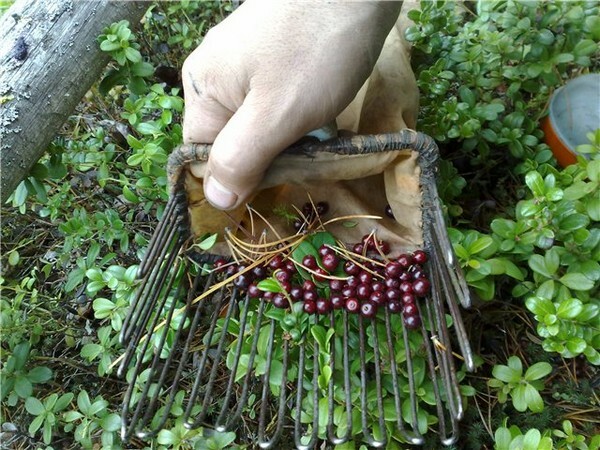
On large industrial plantations, cranberries are harvested using a large amount of water. Do this in this sequence:
- Plantation of cranberries are located in specially opened pits - checks.
- Ripe cranberries in the poured water.
- Cranberry berries are lighter than water, so they float to the surface, but do not come off.
- In the water, they begin to oscillate specially with the installation, so that the wave created in this manner would help to separate the berries from the pedicels.
- Then the big sieves are collected from the surface of the berries.
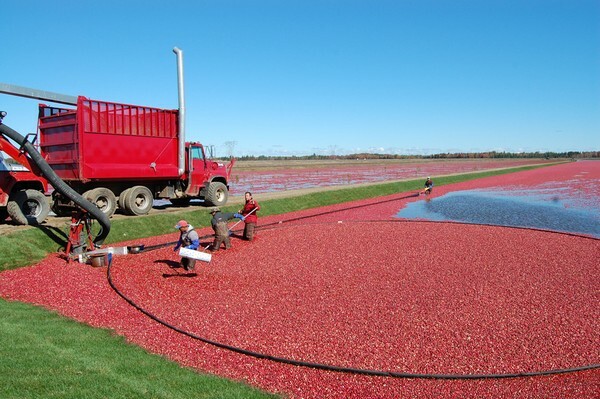
Berry storage
After the harvest is harvested, the berry is processed or sent for storage. Well preserved cranberries in special small boxes or in plastic bags with air access.
But the optimum temperature is very difficult to achieve, so the method of storing cranberries in boiled water is used. In this case, the prepared washed berries are placed in glass jars or wooden barrels and filled with cold, settled boiling water. Keep these blanks in a cool, up to 10 degrees, the room.
It is impossible not to mention such a way of storing cranberries as its freezing. But the berries that are thawed in the future are akin to the fact that they are harvested in winter, they easily burst with the slightest pressure and, of course, they lose most of the nutrients.
Also stored and dried berries. To do this, proceed as follows:
- Drop the berries into sugar syrup.
- Take out with a noise and lay it on a baking sheet on parchment paper.
- Put the baking in the oven and at a low temperature, 70-80 degrees, dry it.
In addition, they store the harvest, pouring sugar, getting a kind of "live" jam. For lovers of sweeter delicacies, there are always a large number of recipes for jam, jams or other "yummies" from a useful berry. In any case, this healing berry will not be superfluous in the pantry of any mistress. It's not for nothing that cranberries are also called the "northern lemon", remembering how many people she saved and saved from beriberi and related diseases.
At the end of our narrative, we want to offer you to watch an interesting video about the cranberry festival in Canada:
